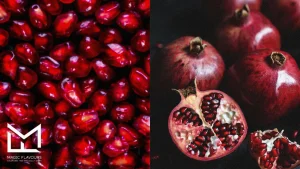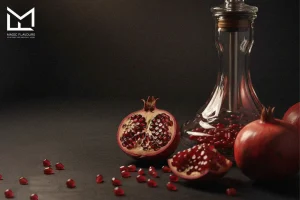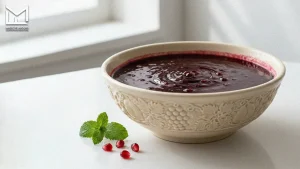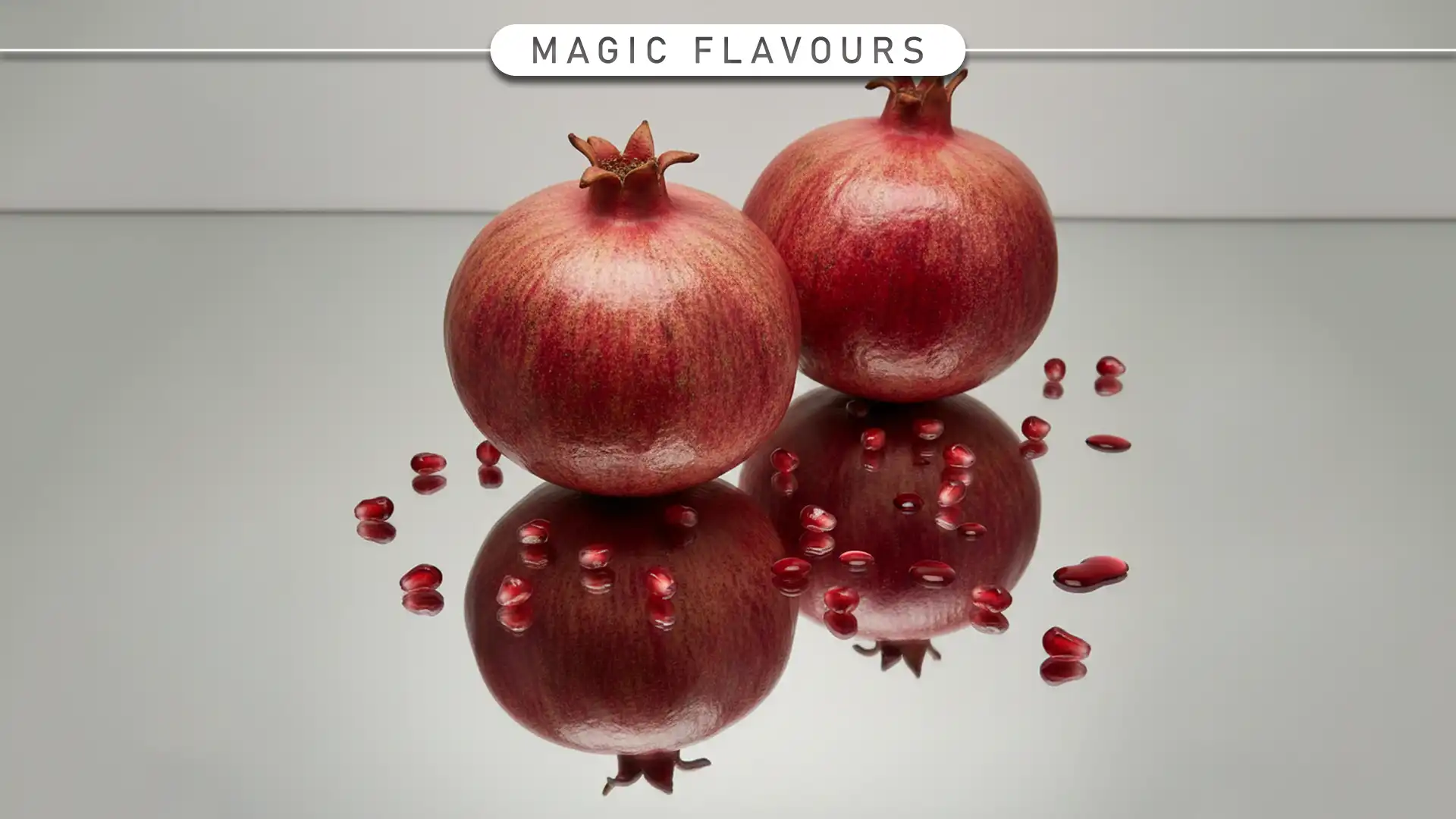1: The Sensory Power of Pomegranate Flavor
Tart, Sweet, and Deeply Red: What Makes Pomegranate Flavor Stand Out
Pomegranate flavor stands out because it balances tartness with subtle sweetness. This contrast creates a bold and memorable profile. While some fruits lean one way, this flavor offers complexity. That’s why it works across categories.
Its depth comes from tannins and natural acids. These elements add grip and richness. Because of this, this flavor feels more grown-up than other red fruits. It’s not just juicy—it’s structured.
Even in blends, pomegranate flavor holds its own. It anchors tropical mixes and elevates berry combinations. That’s why developers use it as both base and accent. So, it’s versatile and emotionally resonant.
Aromatics and Acidity: The Chemistry Behind the Bite

Pomegranate flavor contains key volatiles like hexanal and ethyl butyrate. These compounds shape aroma and freshness. Because they’re delicate, formulation must protect them. Even mild heat can reduce their impact.
Acidity also plays a major role. Pomegranate flavor includes citric and malic acids, which sharpen perception. That’s why it feels bright and clean. However, too much acidity can overpower. So, balance is essential.
When you manage volatiles and acids well, this flavor feels layered. It starts tart, then softens into sweetness. Because of this, it creates a dynamic sensory arc. That’s why it’s favored in premium formats.
Texture and Mouthfeel: How Pomegranate Flavor Shapes Experience
Pomegranate flavor influences texture perception. Because it’s tannic, it adds grip and dryness. This effect mimics wine or tea. That’s why it feels sophisticated in adult formats.
In soft applications like gummies, this flavor adds contrast. It cuts through sweetness and enhances chew. Meanwhile, in beverages, it sharpens mouthfeel. So, it supports both clarity and structure.
Developers often pair pomegranate flavor with smooth textures. Creamy bases or gelatin formats soften its edge. Because of this, it becomes more approachable. That’s why texture strategy matters in flavor design.
Color Psychology: Pomegranate Flavor as a Signal of Richness and Vitality
Pomegranate flavor is linked to deep red hues. Because color influences emotion, it enhances perception. Red signals richness, vitality, and indulgence. That’s why it works well in wellness and luxury formats.
Consumers expect bold taste from bold color. When they see deep red, they anticipate intensity. Pomegranate flavor delivers on that promise. So, color and flavor reinforce each other.
In branding, red also suggests strength and confidence. That’s why this flavor supports powerful positioning. Whether in supplements or hookah molasses, it feels vibrant and alive.
2: What ‘Natural’ Really Means
Defining Natural Pomegranate Flavor: Clean Label, Real Fruit, Real Impact
Natural pomegranate flavor supports clean-label goals. Because it comes from real fruit, it builds trust and emotional connection. That’s why it’s used in wellness and premium formats.
The term “natural” varies by region. In most cases, it means flavor derived from fruit, peel, or juice. Because of this, sourcing matters. Developers must clarify origin and process.
Natural pomegranate flavor also supports storytelling. When brands explain how it’s made, they build credibility. So, flavor becomes more than taste—it becomes a message.
Sources: Juice Concentrates, Extracts, and FTNF
Pomegranate flavor can come from several sources. Juice concentrates offer body, while extracts deliver brightness. Because each format behaves differently, testing is essential.
FTNF (From the Named Fruit) remains the gold standard. It preserves full sensory range and supports premium claims. That’s why it’s preferred in functional and luxury products.
Some suppliers use enzymatic or fermented pomegranate compounds. While technically natural, these may shift flavor. Because of this, developers must compare formats before scaling. This flavor deserves precision.
Regulatory Landscape: EU vs US Definitions
Regulations shape how this flavor is labeled. In the US, “natural” includes flavors from natural sources—even if modified. Because of this, enzymatic formats may qualify.
The EU takes a stricter view. Pomegranate flavor must come directly from the named fruit. That’s why FTNF is often required. If other fruits are used, the claim may not hold.
Global launches require careful planning. Because rules differ, labels must adapt. So, regulatory strategy becomes part of flavor development. This flavor must meet both sensory and legal standards.
Consumer Perception: Natural vs Artificial Pomegranate Flavor
Consumers respond emotionally to “natural.” Because of this, thise flavor must feel real. Artificial versions may mimic taste, but they lack trust.
In blind tests, natural flavor often wins. It feels fuller, richer, and more authentic. That’s why it performs better in wellness and lifestyle formats.
Storytelling supports perception. When brands explain origin and extraction, they build loyalty. So, this flavor becomes more than a taste—it becomes a promise.
3: Technical Formulation Insights
Formulating with Natural Pomegranate Flavor: Challenges and Opportunities
Pomegranate flavor offers boldness, but it brings technical challenges. Because it’s tannic and acidic, stability becomes a key concern. That’s why developers must test early.
In beverages, this flavor may clash with proteins or vitamins. Because of this, emulsifiers or encapsulation can improve performance. So, formulation choices shape success.
Despite complexity, this flavor delivers strong emotional payoff. It feels rich, uncommon, and health-forward. That’s why it’s worth the effort. With the right system, it shines.
Solubility and Stability in Acidic and High-Tannin Systems
Pomegranate flavor often appears in acidic formats like sodas and shots. Because of this, solubility must be managed carefully. Oil-based formats may separate or cloud.
Tannins also affect stability. They may bind with other ingredients or shift over time. That’s why buffering agents or antioxidants help. So, pomegranate flavor stays fresh longer.
Encapsulation improves both solubility and shelf life. It protects aroma and taste from oxidation. Because of this, it’s ideal for functional and wellness products.
Heat and Light Sensitivity: Protecting the Profile
Pomegranate flavor is sensitive to heat and light. Because of this, processing conditions must be controlled. High temperatures can dull its brightness.
Light exposure may trigger oxidation or off-notes. That’s why packaging matters. Amber bottles or foil wraps help protect this flavor integrity.
Antioxidants also support stability. They slow degradation and extend shelf life. So, this flavor stays vibrant longer. That’s why testing is essential before launch.
Pairing and Layering: Pomegranate Flavor with Mint, Vanilla, and Smoke
Pomegranate flavor pairs well with cooling and creamy notes. Mint adds freshness, while vanilla softens acidity. Because of this, blends feel balanced.
Smoke adds depth and intrigue. When layered with this flavor, it creates a bold, modern profile. That’s why it works in hookah molasses and adult formats.
Pairing also helps target different audiences. Sweet blends suit youth markets. Spiced or smoked versions appeal to adults. So, this flavor becomes a flexible tool.
4: Application Spotlight
Pomegranate Flavor in Beverages: From Botanical Sodas to Functional Shots
Pomegranate flavor adds depth and brightness to beverages. Because it’s tart-sweet, it balances both botanical and fruity profiles. That’s why it’s used in sodas, teas, and shots.
In functional drinks, this flavor signals health. It pairs well with adaptogens, collagen, and vitamins. Because of this, it supports wellness positioning. So, it’s ideal for immunity and energy formats.
Carbonation lifts aroma and sharpens mouthfeel. That’s why this flavor works in sparkling waters and mixers. Whether bold or subtle, it delivers sensory impact.
Pomegranate Flavor in Confectionery: Tart Chews, Gummies, and Chocolate
Pomegranate flavor adds contrast to sweet confections. Because it’s tart, it cuts through sugar and enhances complexity. That’s why it’s used in chews and gummies.
In chocolate, this flavor brings fruit-forward brightness. It complements dark cocoa and adds a premium feel. So, it supports indulgent and sophisticated formats.
Texture also matters. Pomegranate flavor unfolds differently in soft vs hard formats. Because of this, developers must match flavor to mouthfeel. That’s why testing is key.
Pomegranate Flavor in Wellness: Supplements and Nutraceuticals
Pomegranate flavor supports wellness products with both taste and meaning. Because it’s linked to antioxidants, it signals health and vitality. That’s why it’s used in supplements and powders.
In tablets and effervescent, this flavor masks bitterness. It improves mouthfeel and boosts compliance. So, it helps consumers stick to routines.
Natural formats matter most. That’s why FTNF and juice-based this flavor perform better. They feel real, clean, and trustworthy. Because of this, they drive repeat purchase.
Pomegranate Flavor in Hookah Molasses: A Signature Base

Pomegranate flavor anchors many hookah blends. Because it’s bold and balanced, it supports both fruity and creamy profiles. That’s why it’s often used as a base.
It pairs well with mint, vanilla, and smoke. These layers add depth and contrast. So, this flavor creates a smooth, vibrant session.
Heat and moisture affect release. Because of this, stability matters. When formulated well, this flavor delivers lasting aroma and taste. That’s why it’s a favorite in molasses design.
5: Market Trends and Consumer Drivers
Superfruit Status and Health Halo: Why Pomegranate Flavor Leads
Pomegranate flavor benefits from its superfruit reputation. Because it’s linked to antioxidants, it signals health and vitality. That’s why it appears in wellness products.
Consumers associate this flavor with immunity, heart health, and anti-aging. These perceptions boost purchase intent. So, flavor becomes a functional cue. Even in indulgent formats, it feels beneficial.
The health halo also supports premium pricing. Because this flavor feels rich and purposeful, it justifies higher value. That’s why it performs well in lifestyle and nutraceutical launches.
Natural Claims and Purchase Intent: Pomegranate Flavor Builds Trust
Natural pomegranate flavor drives consumer trust. Because shoppers read labels, “natural” claims influence buying decisions. That’s why clean-label formats matter.
FTNF and juice-based flavor feel authentic. They support transparency and emotional connection. So, they outperform artificial versions in wellness and premium categories.
Storytelling strengthens impact. When brands explain sourcing and extraction, they build loyalty. Because of this, pomegranate flavor becomes more than taste—it becomes a promise.
Gen Z and Millennial Preferences: Bold, Uncommon, and Trustworthy
Gen Z and Millennials love bold flavors. This flavor delivers intensity, complexity, and cultural depth. That’s why it feels modern and exciting.
These consumers also value authenticity. Natural pomegranate flavor aligns with their clean-label expectations. Because of this, it supports trust and repeat purchase.
Uncommon appeal matters too. This flavor connects to global traditions and wellness rituals. So, it feels both familiar and aspirational. That’s why it thrives in trend-driven formats.
6: Strategic Positioning Tips
Storytelling Through Origin and Extraction: How to Elevate Pomegranate Flavor
Pomegranate flavor becomes more powerful when you tell its story. Because origin matters, highlight where the fruit was grown. Whether it’s Mediterranean or Middle Eastern, each region adds emotional depth. That’s why sourcing supports brand identity.
Extraction also shapes perception. Cold-pressed juice feels fresh, while FTNF signals authenticity. Because of this, process becomes part of the message. When you explain how this flavor is made, you build trust. So, transparency drives value.
Even technical details can feel engaging. Mentioning peel vs aril extraction adds nuance. Because of this, this flavor becomes more than a label—it becomes a sensory promise.
Sensory Language That Sells: Describing Pomegranate Flavor with Impact
Words shape experience. Because consumers can’t taste before buying, language must do the work. That’s why sensory storytelling matters. This flavor should sound bold, juicy, and layered.
Avoid vague terms like “fruity.” Instead, describe the tart burst, the dry grip, the lingering sweetness. Because of this, your copy feels alive. Whether in brochures or LinkedIn posts, sensory words drive engagement.
Use comparisons to guide expectation. This flavor can be “like ruby juice with a twist” or “a bold kiss of tartness.” So, language becomes your flavor tool. That’s why copywriting supports conversion.
Blending Pomegranate Flavor with Emerging Trends: Staying Ahead of the Curve

Pomegranate flavor stays relevant by blending with new trends. Because it’s flexible, it pairs well with botanicals, spices, and florals. That’s why developers use it in immunity blends and mood boosters.
Emerging formats also matter. Pomegranate flavor works in gels, sprays, and dissolvable. Because of this, it supports innovation across delivery systems. So, it’s not just about taste—it’s about experience.
Trend alignment builds credibility. When this flavor joins adaptogens or nootropics, it feels modern. That’s why it appears in wellness and lifestyle launches. This flavor evolves, and your positioning should too.
7: Conclusion
Pomegranate Flavor Is More Than a Trend—It’s a Statement
Pomegranate flavor delivers more than taste—it signals boldness, health, and emotional depth. Because of this, it stands out in every category. Whether in wellness drinks or hookah molasses, this flavor feels intentional and impactful.
It also adapts to changing consumer needs. From clean-label to indulgent formats, this flavor stays relevant. That’s why it supports both innovation and tradition. So, it’s not just a flavor—it’s a strategic choice.
When used with care, this flavor builds brand identity. It evokes richness, vitality, and trust. That’s why it deserves thoughtful formulation and storytelling.
Final Takeaways for R&D and Marketing Teams
Pomegranate flavor offers technical complexity and emotional power. Because of this, it requires cross-functional collaboration. R&D teams should explore stability, solubility, and pairing strategies. Meanwhile, marketers must highlight origin, extraction, and sensory appeal.
Shared language matters. When flavor scientists and brand teams align, this flavor performs better. That’s why early communication supports success. So, build flavor stories that resonate with both developers and buyers.
This flavor isn’t just an ingredient—it’s a message. Because of this, every detail counts. From sourcing to copywriting, it shapes perception and drives results.
Sampling, Collaboration, and Innovation
Now is the time to explore this flavor more deeply. Request samples, run stability tests, and build layered blends. Because hands-on experience drives insight, sampling is essential.
Collaborate across teams to unlock full potential. Whether you’re launching a new beverage or reformulating a classic, this flavor can lead the way. That’s why early alignment matters.
Innovation starts with curiosity. So, ask questions, test formats, and challenge assumptions. Pomegranate flavor is ready to evolve—and your next product could be the proof.

